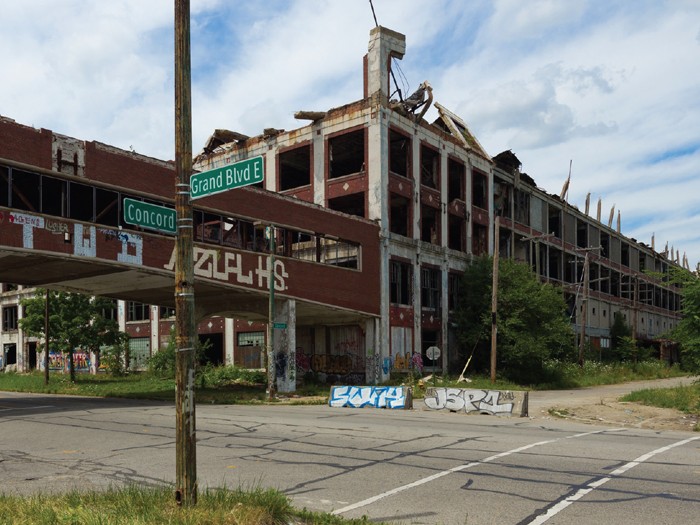Property Risk
Revving Up Motor City

Soaring unemployment, a dwindling population and the collapse of its automotive industry — not to mention a largely dysfunctional property market — all contributed to Detroit’s infamous demise.
The city hit rock bottom on July 18, 2013, when it filed for Chapter 9 bankruptcy with a staggering $18.5 billion debt — the largest municipal bankruptcy in U.S. history.
But in November 2014, having secured a major restructuring deal, Detroit emerged from bankruptcy, offering a new dawn of hope for the city’s residents.
The key to that brighter future is the city’s real estate market, which is undergoing a boom. Investors are snapping up vacant commercial and residential properties for redevelopment.
But variations between real estate market values and replacement costs are making some projects fiendishly difficult to insure.
VIDEO: The Telegraph visits the abandoned skyscrapers of Detroit, where the population has fallen from 2 million to 800,000, and some residents and entrepreneurs who are searching for solutions.
Redevelopment Renaissance
Investment is red hot in the 7.2-square-mile area that stretches from Downtown, Corktown and Midtown to the riverfront and Lafayette Park, with new restaurants and retail outlets opening every week.
Investors from far and wide, including Warren Buffett, are being lured by cheap property prices, and the revitalization of the city’s hub is driving demand for the newly converted apartments and business premises.
Such is the pace of growth that more than two dozen development projects have been completed or are in progress, according to the Downtown Detroit Partnership, a public-private partnership aimed at revitalizing the city.
These include the new $450 million Detroit Red Wings arena, and the renovation of the former Packard plant, which has stood derelict since the late 1990s.
“It’s been a contagion that’s spread, with investors keen to snap up a piece of real estate and tenants opening stores and restaurants all over the city.” — Daniel Stern, partner, Lormax Stern Development
Driving this redevelopment boom are entrepreneurs such as Detroiter Dan Gilbert, CEO of Quicken Loans, who has pumped more than $1.5 billion into 65 projects across the city over the last five years.
Allan Mallach, senior fellow at the Center for Community Progress, a Washington, D.C.-based advocate for land reuse and neighborhood revitalization, said that the bankruptcy and restructuring has given the city a fresh start.
“What it has done is to relieve some of the financial obligations that had to be met, which, in turn, has improved the net picture,” he said.
Daniel Stern, partner at Lormax Stern Development, a real estate developer, said another positive is that commercial prices climbed dramatically during the bankruptcy, particularly in the Downtown and Midtown areas.
“It’s been a contagion that’s spread, with investors keen to snap up a piece of real estate and tenants opening stores and restaurants all over the city,” he said. “In the last year alone we have had about 15 new restaurants open, which is more than we had in the last 10 years.”
Tale of Two Cities
But while Downtown is undergoing a renaissance, the contrast with the more deprived areas of the city couldn’t be starker.
Detroit’s housing market bubble burst in 2006, and the financial crisis two years later sped up the precipitous decline. It resulted in an acceleration of the number of abandoned homes in the city, with around 78,000 buildings and as many as 100,000 homes currently standing vacant, according to the latest estimates.
According to the Wayne County Treasurer’s office records, more than 17,000 foreclosed properties were sold at auction last year, mainly in Detroit, with some properties going for as little as $500.
One of the main challenges for Detroit now is to extend the success enjoyed Downtown to the more struggling areas within the city’s 138-square-mile limits.
“Since the bubble burst in 2006,” Mallach said, “people’s mentality has been that the city is on the way downhill and that their property prices can only go one way so they might as well get out.
“To that extent, the bankruptcy process and the emergence from bankruptcy has started to change that mind-set and has given people a new hope.
“The fact is that the city is now getting more attention from prospective investors, but the question is whether they are the right kind of investors with long-term horizons or simply those who want to make a quick buck within three or four years.”
Risky Business
Buying a property in these areas is easy, but getting a mortgage is a whole different matter, particularly in the more deprived neighborhoods, according to Eric Larson, CEO of the Detroit Downtown Partnership.
“The biggest challenge is that it’s nearly impossible to get a mortgage and to leverage these types of properties because you just don’t have the market comparables to support any kind of structured debt,” he said.
Another problem is that some of Detroit’s older buildings are harder to insure because they are more susceptible to mechanical and electrical faults and pipes bursting, particularly in the winter, when temperatures can drop below 32 degrees, said Rick Miller, national property practice leader for Aon Risk Solutions.
“From an insurance perspective, if a property is in disrepair or neglected, you have to look at whether its mechanical and electrical systems are functioning properly and whether there has been any water damage,” he said.
“Then there is the ‘neighborhood effect’ where you might buy a property in an area where there is a problem with vandalism and crime that could potentially impact you when trying to get insurance.”
Michael Adkins, vice president and manager of Chubb Group of Insurance Cos. in Troy, Mich., said: “Structural deficiencies in a property may increase the severity of a loss and could lengthen the time it takes to get the property back to its intended business purpose.”
Valuing the property can also be problematic, given the huge discrepancy between market value and replacement value costs in some areas, said Adkins.
“I see a lot of buyers’ reports where the purchase price is in no way reflective of the replacement costs.”— Martha Bane, managing director, property practice, Arthur J. Gallagher & Co.
“Commercial real estate owners often look to insure property based on what they paid for the building or the market value,” he said. “But the property’s value could be more or less than the actual cost to replace the structure based on construction costs at the time of the loss.”
Martha Bane, managing director of Arthur J. Gallagher & Co.’s property practice, added: “I see a lot of buyers’ reports where the purchase price is in no way reflective of the replacement costs.”
Brian Ruane, who leads Willis’ real estate practice, said that occupancy was another issue.
“One of the main factors that underwriters look at when assessing a property is occupancy,” he said.
“Low vacancy rates can increase the risk of vandalism and, in the case of rental properties, the owner’s ability to keep up with their tax and mortgage repayments if they have no tenants.”
Property Woes
But, above all, the No. 1 challenge remains kick-starting the city’s mainly under-performing housing market.
One insider told Risk & Insurance® that the city’s bankruptcy merely compounded the fact that Detroit remains one of the weakest property markets in the country.
“Detroit has the lowest commercial office rents, the highest vacancy rates and the lowest prices for single family housing anywhere in the U.S.,” he said.
“The risks involved in getting into the market are considerable, but one of the main advantages with Detroit is that you can come in and make an instant impact. Within a year you can be running your own business or managing three or four rental properties.”
Stefan Hilts, a director in Fitch’s U.S. RMBS group, said the city’s house prices are still 36 percent lower, in real terms, than their peak in April 2006, just before the bubble burst, mainly as a result of a falling population, rising unemployment and a weak economy.
“Prices are still massively undervalued given that there’s still a population and there’re still people working in the city,” he said.
However, a number of institutional and individual investors from Wall Street to China willing to take the plunge have been lured by the low prices, which have started to climb again in the more desirable areas.
Dr. Svenja Gudell, senior economist at property firm Zillow, warned however that there could be tough times ahead if the less well off areas continued to struggle.
“Roughly 30 percent of Detroit’s housing units already lie vacant, and without job growth and a healthy economy to attract new workers, what demand there is will inevitably dry up.
“Those homes currently vacant will remain so, blighting the cityscape and creating the double whammy of downward price pressure in the city’s neighborhoods.”
But while hope remains, the prospects for Detroit’s property market, at least in the short-term, are looking up.
Larson said: “I think that Detroit is going to be in significantly better shape post-bankruptcy, but we need to make sure that we don’t become just a tale of two cities.”












